4th February 2025

It’s been a mixed bag of weather this winter with a very wet December (161mm) after a dry November (27mm). The course received a welcome 2 week break in January after a good fall of snow and then some freezing temperatures followed. The course is holding up well despite the heavy play and foot traffic and some milder weather recently has allowed us to get on with some jobs.
 The 11th Medal tee extension is progressing well and we just have the teeing surface to turf and with a good grow in should be ready for use around May time. This new tee really opens up the dogleg aspect of the hole.
The 11th Medal tee extension is progressing well and we just have the teeing surface to turf and with a good grow in should be ready for use around May time. This new tee really opens up the dogleg aspect of the hole.
All this sandy material came from the hole we dug on the right hand side of the 3rd fairway. We have turned this into a grassy hollow/bunker and gives this otherwise bland stretch of rough some identity now. 

JF Job contractors will be continuing the coastal protection works over the next two weeks. The remaining stretch along the 1st hole and the section beyond the 2nd tee up to the gabions will be completed. 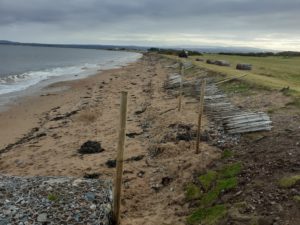
Beyond the gabions along the 2nd hole we have transferred some of the chestnut fencing and will be backfilling over time to help build up this stretch.
Back on the course we have our early Spring work to complete ahead of the season. Jobs such as seeding greens, sanding and spraying wetting agent to fairways and tees. Painting jobs. Getting the newly revetted bunkers in play for mid March along with the rest trimmed up. (14 done this season) Priming and checking the irrigation system is all set and ready to go.
George Paterson
Head Greenkeeper



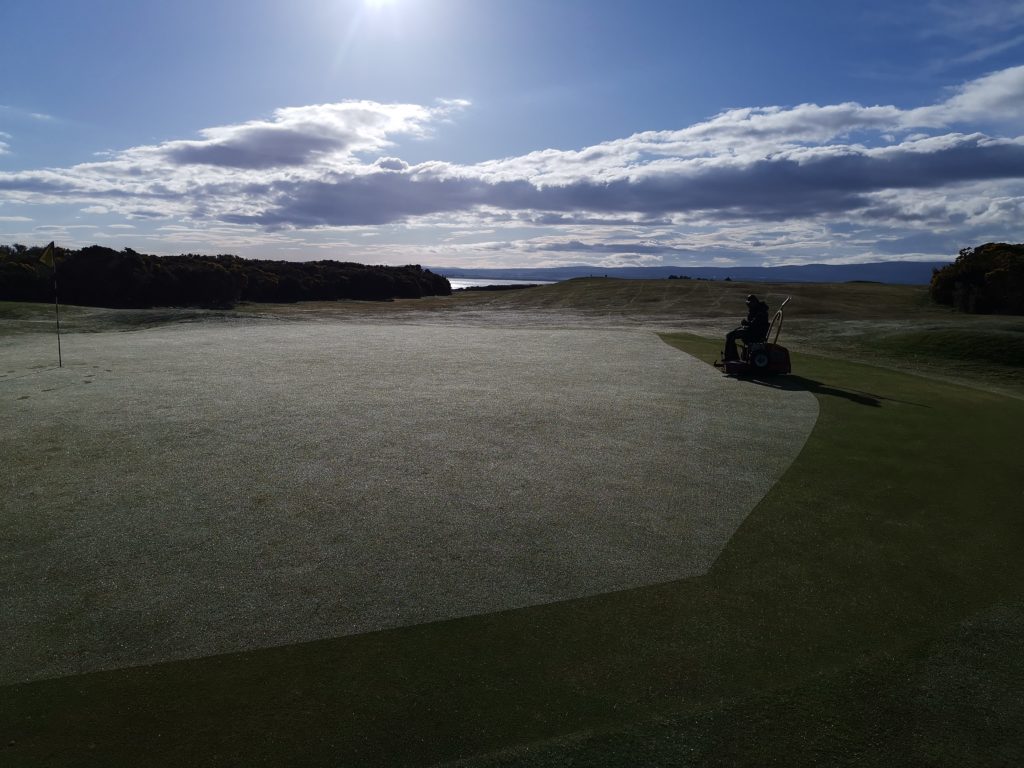
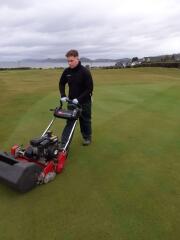
 7th greenside bunker
7th greenside bunker Work on the greens took place in February when we gave them a solid spike followed by a Graden scarify and a heavy top dressing. This was quite aggressive at the time and happily they settled down fairly quickly after a week or two and much improved after another couple of dressings of sand. Growth has been extremely slow this year so far and we have only just lowered the mowers to 4.5mm. Our next target is a star spike and a little refinement with the verti cut units, a liquid spray of seaweed/molasses/humic acid and Nitrogen, some more light sand dressings and a Spring feed towards the end of the month. If we can get a wet day without any wind then our first application of wetting agent will go on.
Work on the greens took place in February when we gave them a solid spike followed by a Graden scarify and a heavy top dressing. This was quite aggressive at the time and happily they settled down fairly quickly after a week or two and much improved after another couple of dressings of sand. Growth has been extremely slow this year so far and we have only just lowered the mowers to 4.5mm. Our next target is a star spike and a little refinement with the verti cut units, a liquid spray of seaweed/molasses/humic acid and Nitrogen, some more light sand dressings and a Spring feed towards the end of the month. If we can get a wet day without any wind then our first application of wetting agent will go on. Coastal erosion. Note. Last Autumns high tidal surge coincided with one of the lowest atmospheric pressure readings since 1916. As you are aware plenty work has gone on at the 1st and 2nd holes over the past few weeks. Rock armour has been placed by GF Job at the 1st and 2nd tees to protect these most important areas. In between a short term fix of sand and Marram which was salvaged or reclaimed from the far end of the course and built up back to the exposed manhole covers and re gaining the core path once again. Two rows of chestnut fencing has been staked in to help protect this sand material and aid in any Marram regrowth. Subsequently and unfortunately last weeks high tide has taken a fair chunk of the sand away from the beach edge and some of the fencing will have to be moved inwards. . Long term this area can be re charged with sand and backed up with rock armour when enough funds are raised and become available. The core path area is to be soiled and seeded shortly to restore grass onto it and will be roped off meantime.
Coastal erosion. Note. Last Autumns high tidal surge coincided with one of the lowest atmospheric pressure readings since 1916. As you are aware plenty work has gone on at the 1st and 2nd holes over the past few weeks. Rock armour has been placed by GF Job at the 1st and 2nd tees to protect these most important areas. In between a short term fix of sand and Marram which was salvaged or reclaimed from the far end of the course and built up back to the exposed manhole covers and re gaining the core path once again. Two rows of chestnut fencing has been staked in to help protect this sand material and aid in any Marram regrowth. Subsequently and unfortunately last weeks high tide has taken a fair chunk of the sand away from the beach edge and some of the fencing will have to be moved inwards. . Long term this area can be re charged with sand and backed up with rock armour when enough funds are raised and become available. The core path area is to be soiled and seeded shortly to restore grass onto it and will be roped off meantime.
 helps dilute fibre and in turn promote better soil characteristics for fine grass to tiller into. Some more selective sanding will go on.
helps dilute fibre and in turn promote better soil characteristics for fine grass to tiller into. Some more selective sanding will go on.


 We also dug out the last group of whins on the left of the 4th fairway which gathered a lot of golf balls. We have created another sandscrape which will again catch the stray shot and make for a tricky recovery, meanwhile speeding up play.
We also dug out the last group of whins on the left of the 4th fairway which gathered a lot of golf balls. We have created another sandscrape which will again catch the stray shot and make for a tricky recovery, meanwhile speeding up play.

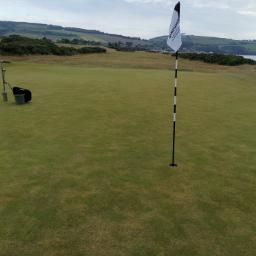 greens in an effort to re wet these bits. We also gave all the greens a close pencil tine down to 5″ to help enable any water to penetrate more evenly. We have more wetting agent to go on at the next opportunity which will hopefully bring back a full recovery. My thoughts are that the Meadow grass (Poa) component in the sward doesn’t like the dry weather and will always be susceptible in weather extremes and when the greens are pushed for speed. The fertility in the greens is also low and particularly the sandier greens which suggests that a light organic feed is imminent and would benefit things overall for the rest of the playing season. We are currently cutting at 3.7mm which is low enough for our site and greens make up but ultimately, if players want faster greens then the greens swards will require more Fescue grasses.
greens in an effort to re wet these bits. We also gave all the greens a close pencil tine down to 5″ to help enable any water to penetrate more evenly. We have more wetting agent to go on at the next opportunity which will hopefully bring back a full recovery. My thoughts are that the Meadow grass (Poa) component in the sward doesn’t like the dry weather and will always be susceptible in weather extremes and when the greens are pushed for speed. The fertility in the greens is also low and particularly the sandier greens which suggests that a light organic feed is imminent and would benefit things overall for the rest of the playing season. We are currently cutting at 3.7mm which is low enough for our site and greens make up but ultimately, if players want faster greens then the greens swards will require more Fescue grasses. Our roughs have pretty much looked after themselves this summer with no summer cut required as they have thinned out with the dry weather. Plenty of colour in them with with dandelions and wild flowers here and there. A cut and collect will be done end of season.
Our roughs have pretty much looked after themselves this summer with no summer cut required as they have thinned out with the dry weather. Plenty of colour in them with with dandelions and wild flowers here and there. A cut and collect will be done end of season.
 Hopefully we will get the fairways deep slit a couple of times this winter and do some much needed verti-drain work. An iron spray will also go on in the next few weeks to knock back any mossy areas.
Hopefully we will get the fairways deep slit a couple of times this winter and do some much needed verti-drain work. An iron spray will also go on in the next few weeks to knock back any mossy areas.
 With the recent dry weather cutting has eased off a bit on the fairways and are only being cut as necessary to avoid any unnecessary additional stress. We have been relentlessly patching and tidying the fairways each week this year with the high level of play and birds turning over divots in search of Leatherjackets. Warne, our new summer labourer has helped greatly along with our staff in keeping the place neat and tidy. We intend not to broadcast spray the fairways for weeds again this year and just to spot treat with the knapsack over the next few weeks. Mainly isolated plantains to deal with here and there. The greens surrounds were blanket sprayed back in early June treating mainly plantains, daisies and bits of clover.
With the recent dry weather cutting has eased off a bit on the fairways and are only being cut as necessary to avoid any unnecessary additional stress. We have been relentlessly patching and tidying the fairways each week this year with the high level of play and birds turning over divots in search of Leatherjackets. Warne, our new summer labourer has helped greatly along with our staff in keeping the place neat and tidy. We intend not to broadcast spray the fairways for weeds again this year and just to spot treat with the knapsack over the next few weeks. Mainly isolated plantains to deal with here and there. The greens surrounds were blanket sprayed back in early June treating mainly plantains, daisies and bits of clover.

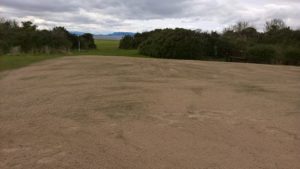 and firming the surfaces up. An Iron and Ammonia spray has gone on last week and a granular feed and wetting agent is planned next.
and firming the surfaces up. An Iron and Ammonia spray has gone on last week and a granular feed and wetting agent is planned next. The range got its first cut this week and is looking great. The downside is that it took almost 2 hours to rake up all the divots and collect golf balls before it could get cut. This is time we can ill afford with a small team of four greenstaff. It would help us greatly if the mats provided could be used or if hitting from the grass then a couple of minutes spent replacing your divots after would be greatly appreciated. Can I remind also that no iron play from behind the main mat and please do not leave divots sprayed over any of the small greens on the range. Thank you.
The range got its first cut this week and is looking great. The downside is that it took almost 2 hours to rake up all the divots and collect golf balls before it could get cut. This is time we can ill afford with a small team of four greenstaff. It would help us greatly if the mats provided could be used or if hitting from the grass then a couple of minutes spent replacing your divots after would be greatly appreciated. Can I remind also that no iron play from behind the main mat and please do not leave divots sprayed over any of the small greens on the range. Thank you.
